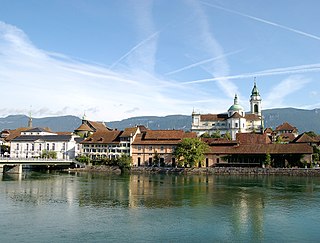
Solothurn is a town, a municipality, and the capital of the canton of Solothurn in Switzerland. It is located in the north-west of Switzerland on the banks of the Aare and on the foot of the Weissenstein Jura mountains.
Ulrich Willerding is a professor emeritus of botany at the Göttingen University, Germany. He is also an instructor at a local high school. Willerding is one of the leading European palaeo-ethnobotanists. He has specialized in Medieval Europe but also done work on other times. One of his special interests is weeds. He has worked on bibliographies of European paleoethnobotany. Although a biologist by training, he has worked extensively with archaeologists.

Amanz Gressly was a Swiss geologist and paleontologist. He introduced the use of the term facies in geology, and is considered one of the founders of modern stratigraphy and paleoecology.

The Junkerngasse is a street in the Old City of Bern, the medieval city center of Bern, Switzerland. It connects the tip of the Aar peninsula to the Münster.

The Marmorpalais is a former royal residence in Potsdam, near Berlin in Germany, built on the grounds of the extensive Neuer Garten on the shores of the Heiliger See (lake). The palace was commissioned by King Friedrich Wilhelm II and designed in the early Neoclassical style by the architects Carl von Gontard and Carl Gotthard Langhans. The palace remained in use by the Hohenzollern family until the early 20th century. It served as a military museum under communist rule, but has since been restored and is once again open to the public.
Glücksburg Castle is one of the most significant Renaissance castles in Northern Europe. The castle was the headquarters of the ducal lines of the house of Glücksburg and temporarily served as the primary residence of the Danish monarch. The building is in the town of Glücksburg, located in Northern Germany on the Flensburg Firth. The structure is a water castle. The ducal house of Glücksburg derived its name from the castle and its family members are related to almost all European dynasties.
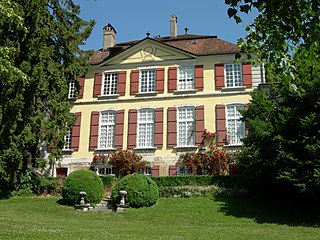
Blumenstein Castle is an estate house in the municipality of Solothurn of the Canton of Solothurn in Switzerland. It is a Swiss heritage site of national significance. In 1952 it became the home of the Historical Museum of Solothurn.

Fracstein Castle is a castle in the municipality of Seewis im Prättigau of the Canton of Graubünden in Switzerland. It is a Swiss heritage site of national significance.

Turicum was a Gallo-Roman settlement at the lower end of Lake Zurich, and precursor of the city of Zürich. It was situated within the Roman province of Gallia Belgica and near the border to the province of Raetia; there was a tax-collecting point for goods traffic on the waterway Walensee–Obersee-Zürichsee–Limmat–Aare–Rhine.

The Royal Palace of Werla is located near Werlaburgdorf in Lower Saxony. The grounds of the royal palace cover about 20 hectares rising atop Kreuzberg hill, a 17 m high natural plateau overlooking the Oker river. In the Early Middle Ages the palace was an important place in the Holy Roman Empire, serving as an important base for the Ottonians in the 10th century in particular. Although it subsequently lost its political significance to the newly established Imperial Palace of Goslar at Rammelsberg, it developed into an independent settlement with a busy industrial quarter. In the 14th century it fell into ruin and was completely unknown until its rediscovery in the 18th century. The core fortress in particular was thoroughly excavated in the 20th century. Excavations carried out since 2007 have brought new understanding to the hitherto largely unexplored outworks. Since 2010 the palace complex with foundation and enceinte, as well as earthworks, has been partially reconstructed and is now open to the public as the Archäologie- und Landschaftspark Kaiserpfalz Werla.
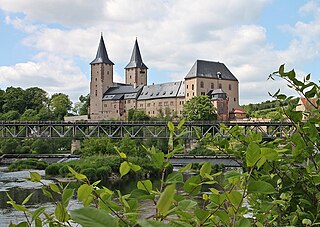
Rochlitz Castle or Rochlitz Palace lies in the west of the town of Rochlitz in the county of Mittelsachsen in the Free State of Saxony. It was built on the site of an imperial castle, erected in the second half of the 10th century, which fell into the possession of the Wettin margraves in 1143. Its appearance, which includes several Romanesque wings, is considerably influenced by its remodelling into a margravial schloss in the fourth quarter of the 14th century. Further conversions and additions followed at the end of the 15th and in the 16th centuries, when the castle became a secondary residenz, dower house and hunting lodge for the Wettin family. The castle or palace was the residence for members of the Saxon princely house eight times. From the 18th century the castle served as an administrative centre ; in 1852 it became a gaol, which necessitated considerable alteration. The museum founded in 1892 was gradually expanded and, today, takes up almost the entire castle.
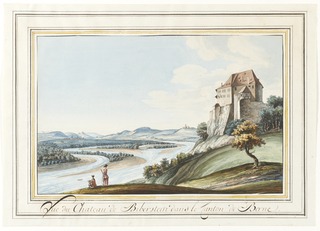
Biberstein Castle is a castle in the municipality of Biberstein in the Swiss canton of Aargau.

The Neckar-Odenwald Limes is a collective term for two, very different early sections of the Upper Germanic-Rhaetian Limes, a Roman defensive frontier line that may have been utilised during slightly different periods in history. The Neckar-Odenwald Limes consists of the northern Odenwald Limes (Odenwaldlimes), a cross-country limes with camps, watchtowers and palisades, which linked the River Main with the Neckar, and the adjoining southern Neckar Limes (Neckarlimes), which in earlier research was seen as a typical 'riverine limes', whereby the river replaced the function of the palisade as an approach obstacle. More recent research has thrown a different light on this way of viewing things that means may have to be relativized in future. The resulting research is ongoing.

A Letzi or Letzimauer refers to defensive barriers whose purpose is to protect the entrance into a valley. The term is Swiss, and such stone barriers were particularly common in medieval Switzerland but were also built in Austria and Germany.

Altreu is a village in the municipality of Selzach in Canton of Solothurn's Lebern District, Switzerland.

Trachslau is a village inside the municipality of Einsiedeln, in the Swiss canton of Schwyz. The village is in the flow of the Alp river. First documented in 1331 as Trechsellum.
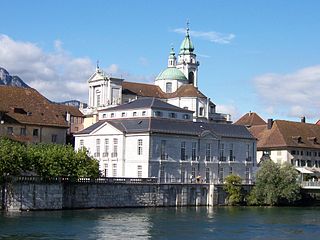
The Kantonales Kulturzentrum Palais Besenval was a state cultural center in the Swiss town of Solothurn that existed from 1990 to 2000. It was located in the Palais Besenval at Kronengasse 1 and served mainly as a Kunsthalle.
Wolfgang Teuchert was a German art historian and historic preservationist.
Matthias Untermann is a German art historian and medieval archaeologist.

















